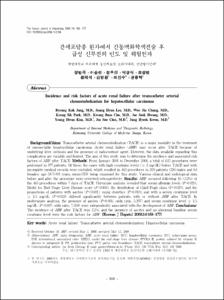KUMEL Repository
1. Journal Papers (연구논문)
1. School of Medicine (의과대학)
Dept. of Internal Medicine (내과학)
간세포암종 환자에서 간동맥화학색전술 후 급성 신부전의 빈도 및 위험인자
- Keimyung Author(s)
- Jang, Byoung Kuk; Chung, Woo Jin; Park, Kyung Sik; Cho, Kwang Bum; Hwang, Jae Seok; Kim, Young Hwan; Choi, Jin Soo; Kwon, Jung Hyeok
- Journal Title
- Korean Jourmal of Hepatology
- Issued Date
- 2008
- Volume
- 14
- Issue
- 2
- Keyword
- Acute renal failure(급성 신부전); Transcatheter arterial chemoembolization(간동맥화학색전술); Hepatocellular carcinoma(간세포 암종)
- Abstract
- Background/Aims: Transcatheter arterial chemoembolization (TACE) is a major modality in the treatment of unresectable hepatocellular carcinoma. Acute renal failure (ARF) may occur after TACE because of underlying liver cirrhosis and the presence of radiocontrast agent. However, the data available regarding this complication are variable and limited. The aim of this study was to determine the incidence and associated risk factors of ARF after TACE. Methods: From January 2001 to December 2004, a total of 632 procedures were performed in 377 patients. Of these, the cases with high creatinine levels (> 2 mg/dL) before TACE and with incomplete medical records were excluded, which resulted in 463 procedures in 319 patients (256 males and 63 females; age 58.7±9.9 years, mean士SD) being examined for this study. Various clinical and radiological data before and after the procedure were reviewed retrospectively. Results: ARF occurred following 15 (3.2%) of the 463 procedures within 7 days of TACE. Univariate analysis revealed that serum albumin levels (P=0.025), Model for End-Stage Liver Disease score (P=0.001), the distribution of Child—Pugh class (P=0.027), and the proportions of patients with ascites (P<0.001), using diuretics (P=0.010), and with a serum creatinine level > 1.5 mg/dL (P=0.023) differed significantly between patients with or without ARF after TACE. In multivariate analysis, the presence of ascites (P=0.005; odds ratio, 5.297) and serum creatinine level > 1.5 mg/dL (P=0.007; odds ratio, 7.358) were independently associated with the development of ARF. Conclusions: The incidence of ARF after TACE was 3.2%, and the presence of ascites and an abnormal baseline serum creatinine level were the risk factors for ARF.
요 약
목적: 간동맥화학색 전술은 간세포암종 환자에서 수술적 절제가 불가능한 경우 시행할 수 있는 중요 한 치료법 중의 하나이다. 하지만 시술 후 여러 가 지 합병증이 발생할 수 있으며, 그 중 급성 신부전 은 기저 질환인 간경변증과 방사선 조영제에 의해 서도 발생될 수 있다. 이 연구는 간동맥화학색전술 후 발생하는 급성 신부전의 빈도와 이와 연관된 위 험인자에 대하여 알아보고자 하였다. 방법: 20이년 1월부터 2004년 11월까지 간세포암종으로 진단받
고간동맥화학색전술을받은환자들중시술전 혈 청 크레아티닌 수치가 2 mg/dL 이상이거나 급성 신부전 발생 유무를 판단할 수 없었던 경우를 제외 한 총 319명의 환자에서 시행된 463회의 간동맥화 학색전술 시술 예를 대상으로 급성 신부전의 발생 률과 위험인자를 후향적으로 분석하였다. 급성 신 부전은 간동맥화학색전술을 시술한 후 1주 이내에 크레아티닌 수치가 기저치의 50% 이상 증가하여 1.5 mg/dL 이상으로 상승한 경우와, 시술 전 신기 능장애가 있었던 환자로서(1.5 mg/dL ^ Cr < 2.0 mg/dL) 크레아티닌 수치가 기저치보다 50% 이상 증가한 경우로 정의하였다. 결과: 급성 신부전은 간동맥화학색전술 시술 후 1주 이내에 총 463예 중 15예에서 발생하여 3.2%의 발생률을 보였고, 이 중 남자 11예(73.3%), 여자 4예(26.7%)였다. 단변량 분석에서 시술 전복수 유무(P<0.001), MELD 점 수(P=0.001), 시술 전 이뇨제 사용 유무(P=0.010), 시술 전 신기능장애 유무(P=0.023), 시술 전 혈중 알부민 수치(P=0.025), Child—Pugh 등급P=0.027) 이 급성 신부전과 연관된 인자로 나타났으며, 이 인자들을 대상으로 다변량 분석을 시행한 결과 시 술 전 복수CP=0.005; odds ratio, 5.297)와 시술 전 신기능장애(P=0.007; odds ratio, 7.358)의 존재가 급성 신부전 발생의 독립적인 위험인자였다. 급성 신부전이 발생한 환자군의 중앙생존기간은 2.2士 1.4개월이었고, 발생하지 않은 군의 중앙생존기간은 33.5士4.6개월로 유의한 차이가 있었다(P<0.001). 결 론: 간동맥화학색전술 시술 후 급성 신부전의 발생 률은3.2%로 비교적 높지 않았으며, 시술 전복수 와 신기능장애의 존재가 시술 후 급성 신부전 발생 의 위험인자였다.
색인단어: 급성 신부전,간동맥화학색전술, 간세포
암종
- Alternative Title
- Incidence and risk factors of acute renal failure after transcatheter arterial chemoembolization for hepatocellular carcinoma
- Publisher
- School of Medicine
- Citation
- 장병국 et al. (2008). 간세포암종 환자에서 간동맥화학색전술 후 급성 신부전의 빈도 및 위험인자. Korean Jourmal of Hepatology, 14(2), 168–177. doi: 10.3350/kjhep.2008.14.2.168
- Type
- Article
- ISSN
- 1738-222X
- Appears in Collections:
- 1. School of Medicine (의과대학) > Dept. of Internal Medicine (내과학)
1. School of Medicine (의과대학) > Dept. of Radiology (영상의학)
- 파일 목록
-
-
Download
 oak-aaa-4551.pdf
기타 데이터 / 394.42 kB / Adobe PDF
oak-aaa-4551.pdf
기타 데이터 / 394.42 kB / Adobe PDF
-
Items in Repository are protected by copyright, with all rights reserved, unless otherwise indicated.